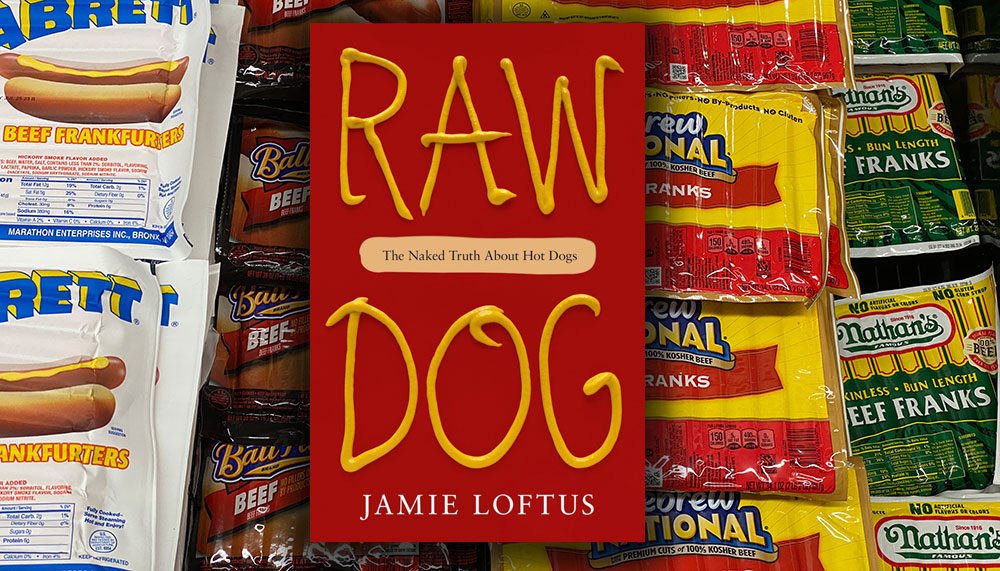Raw Dog: The Naked Truth About Hot Dogs
By Ian MacAllen on Monday, July 17th, 2023 at 2:28 pm

Hot dogs provide an ideal medium for expressing culinary creativity. Across the United States exist hundreds of unique recipes created and loved by local and regional consumers. Comedian and author Jaime Loftus goes on the search for the perfect hot dog in her latest book, Raw Dog: The Naked Truth About Hot Dogs.
It’s quite the scam to convince a publisher to pay for a cross-country road trip, eating various hot dogs along the way. As a hot dog enthusiast myself, I’m obviously a bit jealous she pulled it off. I picked up a copy out of curiosity and the promise of some hot dog history.
Loftus is a professional comedian and podcast host and the appeal of the book proposal no doubt was the promise to make hot dogs funny. Hot dogs, of course, are funny all on their own.
Raw Dog is a first-person narrative mixed with some journalism and a bit of history. The story is also an interesting look at the pandemic as a moment in time. Loftus begins writing when the pandemic is still very much a danger, and throughout the book, she observes different levels of precautions, spikes in new variants, and health concerns of her ailing father. The pandemic is present, but not the focus of the book, which provides a legitimacy to how the story is told. There’s no glossing over the pandemic, but it exists only in the background.
As a history of hot dogs, Loftus is only partly successful. There are moments where Loftus gets into the local history of a hot dog, or a particular hot dog style or shop. These are detailed, and she captures the essence of those places. However, there is not some deeper truth here, no grand hot dog narrative. Instead, for a general history of hot dogs, check out Bruce Kraig’s Hot Dog: A Global History for a better summation of the history. Loftus cites him, too.
Loftus, her boyfriend, and a dog head out to a series of low budget motels while she chows down on a handful of hot dogs each day. She warns us about eating too many hot dogs and finishing the whole dog each time. She worries about toilet access. Good advice for when I set out on my own hot dog eating adventure.
The journey takes Loftus across the country where she does provide background on individual hot dogs along the way. However, the journey starts on the west coast. Since the original hot dogs are from either from Chicago or Brooklyn depending on who you ask, there’s no natural evolution of hot dogs through time in the narrative. It’s a reminder this book is more of a memoir than a history.
Eventually she does arrive on the east coast where there are some curious hot dog choices. She finds the rare Italian Hot Dog, a creation of Italian Americans in New Jersey. And while she finds a ripper to examine, she skips over the Texas Weiner, a New Jersey classic that started out as a Greek immigrant’s attempt to make an Italian bolognese sauce to top his hot dog and accidentally created a sweet, meaty chili sauce.
In New York, she overlooks a few hot dogs as well. For most of the last hundred and forty years of hot dog history, New York has been the number one consumer. Los Angeles has only recently overtaken the city, but Loftus doesn’t dig too deep here, Coney Island aside.
Her reporting on the Coney Island Hot Dog eating contest is great. She attends the July 4th spectacular and goes into the ongoing conflicts between the competitors. I happened on the chapter July 4th, just in time to try tuning into the live event. Unfortunately, this past year, the contest was rain delayed and I couldn’t find the live broadcast. Loftus’s succeeded though in making the experience seem interesting enough to watch on television (and too be honest, sounding like the sort of experience at I try to avoid, preferring Nathan’s off-season).
However, Loftus somehow skips Crift Dogs, a gourmet hot dog shop that ushered in the era of both the fancy hot dog in New York City and also the speakeasy bar. The shop in the East Village serves as the gateway to one of the forerunners of the modern speakeasy movement. Loftus arrived to find the restaurant closed and didn’t bother going back. And of course, there is the classic New York combination of hot dogs and Papaya.
Papaya King created an entire market in New York City of pairing inexpensive hot dogs with fruity tropical drinks. The original location on the Upper East Side opened as a juice stand, and only became the Papaya King in the 1950s. Imitators soon followed with dozens of knockoff stands. Perhaps the most famous is Gray’s Papaya, which opened on the West Side. Both Gray’s and Papaya King have expanded and contracted over time, but Papaya Dog still has a mini empire standing across Manhattan. Loftus though finds the time for just a Gray’s Papaya. Their omission might have been an editorial choice rather than an oversight, but these shops all seem pretty significant in the history of hot dogs.
Loftus excels at capturing the experience of eating the hot dogs. It’s more than just describing toppings, but an attempt, generally successfully, of illustrating what eating those dogs is like. She sets the scene, highlighting where these places are in the present history, and in many cases reflects on where they have come from.
The book is as much a personal journey for Loftus as it is a book about hot dogs. The boyfriend she begins the trip with fades away. Her father, who she stays with at times to stage hot dog tasting excursions, is sick and in need of medical care. Ultimately it was not a journey about finding the perfect hot dog, but about growing as a person. It was a fun read, and certainly some future generation of hot dog lovers will look to this text as a resource of how we once ate these sandwiches.

